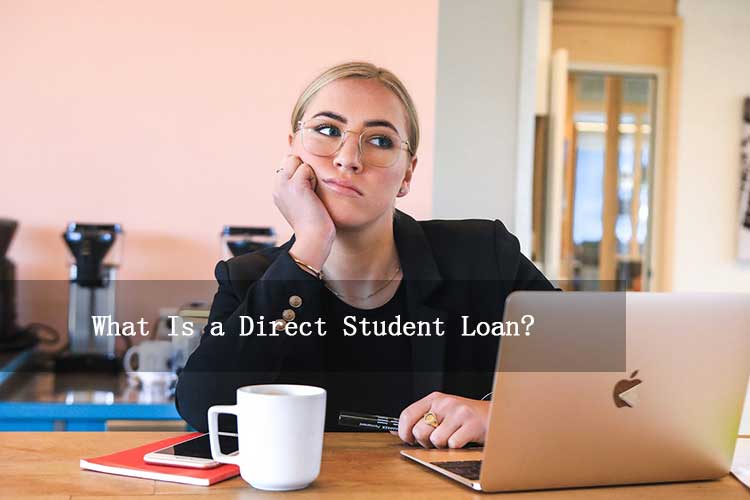
Many students and their families worry about how to pay for higher education. To help alleviate this stress, the federal government provides several loan options, including the Direct Student Loan. If you’re wondering, “What is a direct student loan?”, this detailed guide will cover all the essential information you need, such as eligibility requirements, benefits, and repayment plans.
What Is a Direct Student Loan?
A Direct Student Loan is a federal loan provided by the U.S. Department of Education designed to assist students in financing their higher education expenses. These loans fall under the William D. Ford Federal Direct Loan Program, which is the largest federal student loan initiative. When you take out a loan through this program, you are borrowing directly from the federal government.
Direct student loans are accessible to undergraduate, graduate, and professional students. They come with several advantages over private loans, including lower interest rates, more adaptable repayment options, and the possibility of qualifying for forgiveness programs.
Types of Direct Student Loans
Student loans come in various types, each designed to meet the unique needs of students and their families. Here’s an overview of the different loan options:
1. Direct Subsidized Loans
These loans are specifically for undergraduate students who can show financial need. A major advantage of Direct Subsidized Loans is that the federal government covers the interest while you’re enrolled at least half-time, during the six-month grace period after you graduate, and during any deferment periods. This feature helps prevent your loan balance from increasing while you’re still studying.
2. Direct Unsubsidized Loans
In contrast to subsidized loans, Direct Unsubsidized Loans are available to both undergraduate and graduate students without the need to prove financial need. However, you will be responsible for all interest that accumulates on the loan, even while you’re in school. If you decide not to pay the interest during your studies or deferment, it will be added to your principal balance.
3. Direct PLUS Loans
Direct PLUS Loans are available for graduate students, professional students, and parents of dependent undergraduate students. These loans require a credit check and typically have a higher interest rate than Direct Subsidized and Unsubsidized Loans. The borrowing limit is determined by the cost of attendance, minus any other financial aid you may receive.
4.Direct Consolidation Loans
A Direct Consolidation Loan lets you merge several federal student loans into one, making it easier to manage with just one monthly payment. This can streamline your repayment process and might even reduce your monthly payment by lengthening the repayment period. Keep in mind, though, that stretching out your repayment term could result in paying more interest in the long run.
Eligibility Requirements for Direct Student Loans
To qualify for a Direct Student Loan, there are a few requirements you need to meet:
- Enrollment: You should be enrolled at least half-time in a recognized degree or certificate program.
- Citizenship: You need to be a U.S. citizen or an eligible non-citizen.
- FAFSA: It’s necessary to complete the Free Application for Federal Student Aid (FAFSA) each academic year to assess your eligibility for federal loans.
- Financial Need: For Direct Subsidized Loans, you must show financial need, which your school will determine based on your FAFSA submission.
How Is Interest Calculated on Direct Student Loans?
Interest on Direct Student Loans is calculated using simple interest, which means it only considers the original loan amount. This type of interest does not compound, so you won’t be charged interest on previously accrued interest. However, if you don’t pay the interest on Direct Unsubsidized Loans or PLUS Loans while you’re still in school, that unpaid interest will be added to your principal balance when the loan enters repayment, a process known as capitalization.
The interest rates for Direct Student Loans are fixed and determined by the federal government each year. For instance, for the 2023-2024 academic year, the interest rates are as follows:
- Direct Subsidized and Unsubsidized Loans (for undergraduates): 5.50%
- Direct Unsubsidized Loans (for graduate students): 7.05%
- Direct PLUS Loans: 8.05%
Repayment Plans for Direct Student Loans
Federal Direct Student Loans offer a variety of repayment options to suit different financial circumstances. Generally, repayment starts six months after you graduate, leave school, or drop below half-time enrollment.
1. Standard Repayment Plan
- Term: 10 years
- Monthly Payments: Fixed amounts
- Best For: Borrowers who can manage higher payments to pay off their loans more quickly.
2. Graduated Repayment Plan
- Term: 10 years
- Monthly Payments: Begin at a lower amount and increase every two years
- Best For: Borrowers anticipating a rise in their income over time.
3. Income-Driven Repayment Plans (IDR)
- Income-Based Repayment (IBR): Monthly payments are set at 10-15% of your discretionary income, with forgiveness available after 20-25 years.
- Pay As You Earn (PAYE) and Revised Pay As You Earn (REPAYE): Similar to IBR, these plans cap payments at 10% of your income, with the remaining balance forgiven after 20-25 years.
- Income-Contingent Repayment (ICR): Payments are either 20% of your discretionary income or what you would pay on a fixed 12-year plan, with forgiveness after 25 years.
These options can be especially beneficial if your income is low compared to your student debt, allowing for monthly payments as low as $0 if your income is very limited.
Loan Forgiveness and Cancellation Options
One of the major advantages of Direct Student Loans is their eligibility for loan forgiveness programs. These programs are not available with private loans.
1. Public Service Loan Forgiveness (PSLF)
Borrowers working full-time for a qualifying employer, such as a government agency or nonprofit organization, may be eligible for loan forgiveness after making 120 qualifying payments under a qualifying repayment plan.
2. Teacher Loan Forgiveness
If you teach full-time for five consecutive years in a low-income school or educational service agency, you may qualify for forgiveness of up to $17,500 on your Direct Loans.
Direct Loans vs. Private Student Loans
Direct student loans offer several benefits that private loans typically don’t. With Direct Loans, you get fixed interest rates, income-driven repayment plans, and the potential for loan forgiveness. Private student loans, on the other hand, often come with variable interest rates and lack flexible repayment options.
If you’re considering taking out student loans, it’s generally best to exhaust your federal loan options before turning to private lenders.
How to Apply for a Direct Student Loan
Applying for a Direct Student Loan is simple and begins with filling out the FAFSA. This application will determine your eligibility for federal financial aid, including grants, work-study programs, and loans. Your school will then send you a financial aid package outlining the loans you qualify for, and you can decide how much you want to borrow.
Steps to Apply:
- Submit the FAFSA: Go to FAFSA.gov to submit your application.
- Review Your Student Aid Report: After submission, you’ll receive a Student Aid Report summarizing your financial aid eligibility.
- Receive Your Financial Aid Offer: Your school will send you a financial aid package, which may include Direct Loans.
- Accept Your Loans: You can choose to accept the full loan amount or a portion of it.
- Complete Entrance Counseling: For first-time borrowers, you’ll need to complete entrance counseling to ensure you understand your loan responsibilities.
- Sign a Master Promissory Note (MPN): This is your agreement to repay the loan.
Conclusion
Understanding what a Direct Student Loan is and how it works is key to managing your education costs effectively. With flexible repayment plans, competitive interest rates, and loan forgiveness options, Direct Student Loans are an excellent option for students looking to finance their education. Be sure to explore all the available options and make an informed decision based on your financial situation and long-term goals.
By knowing the ins and outs of federal loans, you can better navigate your borrowing journey and minimize financial stress down the road.



